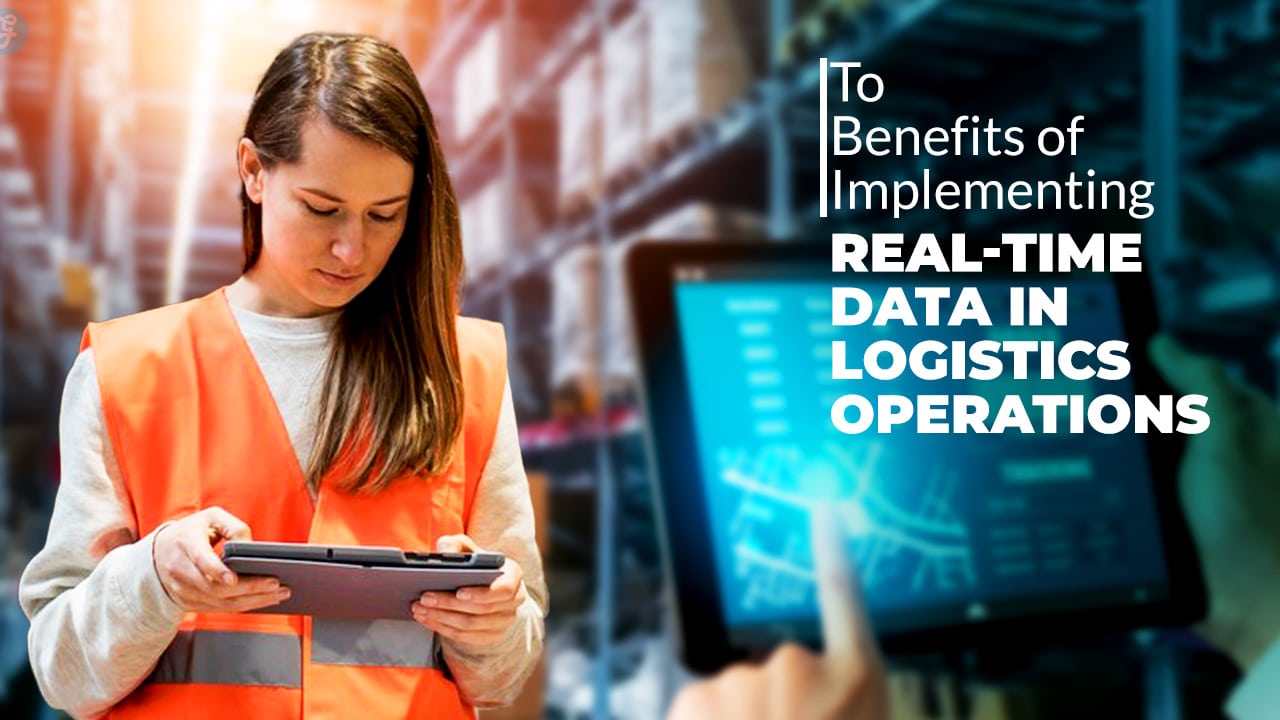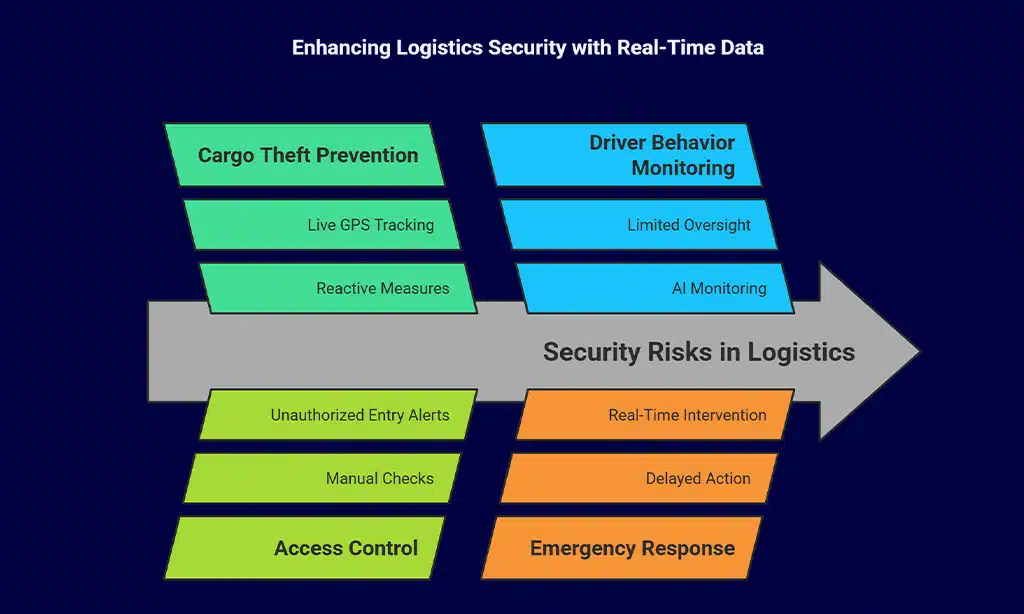In today’s fast-paced logistics industry, real-time data has become a game-changer. Companies that harness live data insights can significantly enhance efficiency, reduce costs, and improve overall supply chain management.
The benefits of implementing real-time data in logistics operations extend far beyond simple tracking; they revolutionize decision-making, security, compliance, and customer satisfaction.
By integrating real-time data, logistics businesses can proactively respond to challenges, optimize routes, and streamline inventory management. As digital transformation accelerates across industries, logistics firms that fail to adopt real-time data solutions risk losing competitiveness.
In this article, we’ll explore the top 10 benefits of implementing real-time data in logistics operations, supported by real-world examples, tables, and key insights.
1. Enhanced Supply Chain Visibility
Supply chain visibility is crucial for logistics efficiency. Implementing real-time data in logistics operations provides end-to-end tracking, allowing businesses to monitor shipments at every stage. This minimizes uncertainties and enhances coordination between suppliers, distributors, and customers.
Real-Time vs. Traditional Supply Chain Visibility
| Factor | Traditional Supply Chain | Real-Time Data Supply Chain |
| Shipment Tracking | Delayed Updates | Live GPS Monitoring |
| Issue Resolution | Reactive Approach | Proactive Problem-Solving |
| Coordination | Manual Communication | Automated Notifications |
| Customer Satisfaction | Moderate | High |
Case Study: Companies Benefiting from Improved Visibility
For example, Amazon leverages real-time data to track millions of deliveries daily, ensuring timely updates for customers. Their logistics network thrives on real-time insights, reducing errors and optimizing supply chain performance. Similarly, DHL utilizes IoT sensors and AI-driven analytics to monitor shipments globally, reducing transit time by 20%.
2. Faster Decision-Making with Live Data Insights
With access to live data, logistics managers can make data-driven decisions instantly. Whether it’s rerouting a delivery due to traffic congestion or addressing an inventory shortage, real-time insights empower businesses to stay ahead of problems before they escalate.
Real-Time Data vs. Delayed Decision-Making
| Decision-Making Factor | Without Real-Time Data | With Real-Time Data |
| Response Time | Delayed | Instant |
| Inventory Adjustments | Reactive | Proactive |
| Route Optimization | Manual Planning | AI-Based Changes |
Key Advantages:
- Quick response to delays
- Reduced operational downtime
- Improved coordination between teams
3. Improved Route Optimization and Fuel Efficiency
Real-time data enables dynamic rerouting based on current traffic conditions, helping logistics companies reduce transit times and fuel consumption. This significantly enhances cost-efficiency and environmental sustainability.
Comparison of Traditional vs. Real-Time Route Optimization
| Factor | Traditional Route Planning | Real-Time Data Optimization |
| Accuracy | Low | High |
| Traffic Adaptability | None | Instant Adjustments |
| Fuel Efficiency | Moderate | Maximum Savings |
4. Reduction in Operational Costs
One of the most significant benefits of implementing real-time data in logistics operations is cost reduction. Companies can eliminate inefficiencies, reduce wastage, and optimize resource utilization by utilizing real-time analytics and automation.
Cost Reduction Factors with Real-Time Data
| Cost Factor | Traditional Logistics | Real-Time Data-Driven Logistics |
| Fuel Expenses | High due to fixed routes | Lower with optimized routes and live traffic updates |
| Fleet Utilization | Idle time increases costs | Maximized with dynamic scheduling |
| Delay-Related Expenses | Increased due to late response | Minimized with predictive analytics |
| Warehouse Costs | Overstocking and stockouts | Optimized inventory with live data |
| Labor Costs | Inefficient resource allocation | Automated workflow adjustments |
Additional Cost-Saving Benefits:
- Lower fuel expenses through intelligent route planning and AI-driven logistics.
- Better fleet utilization by reducing downtime and optimizing vehicle dispatch.
- Prevention of unnecessary delays using predictive analytics to anticipate disruptions.
- Reduced labor costs by automating manual processes and improving efficiency.
- Minimized storage costs through real-time inventory tracking to avoid overstocking or shortages.
By leveraging real-time data in logistics operations, companies can not only reduce expenses but also increase profitability and operational efficiency.
5. Enhanced Customer Satisfaction and Experience
Customers today expect accurate, real-time updates on their shipments. Implementing real-time data in logistics operations allows businesses to provide precise estimated delivery times (ETAs), enhancing customer trust and satisfaction. Customers can access live tracking portals or mobile apps to receive real-time alerts on their deliveries.
Impact of Real-Time Customer Tracking on Satisfaction
| Customer Expectation | Without Real-Time Data | With Real-Time Data |
| Delivery Time Accuracy | Inconsistent | Highly Accurate |
| Transparency | Limited Information | Live Tracking & Notifications |
| Customer Complaints | High | Reduced Issues |
| Trust & Retention | Low | High Engagement |
List: Benefits of Real-Time Customer Updates
- Increased transparency and reliability, leading to higher customer confidence.
- Reduced customer complaints and inquiries, as real-time tracking eliminates uncertainty.
- Higher customer retention rates, due to improved delivery experiences and satisfaction.
- Proactive customer service, allowing businesses to notify customers instantly about delays or issues.
6. Improved Warehouse and Inventory Management
Real-time inventory tracking prevents stockouts and overstocking, ensuring optimal stock levels at all times. This enhances warehouse efficiency, reduces storage costs, and helps businesses avoid lost sales due to unavailable stock. By leveraging live data, logistics companies can optimize warehouse layouts, improve picking accuracy, and maintain an optimal balance between supply and demand.
Benefits of Real-Time Data in Warehouse Operations
| Factor | Without Real-Time Data | With Real-Time Data |
| Inventory Accuracy | Low | High |
| Restocking Efficiency | Manual and Delayed | Automated and Instant |
| Shrinkage Levels | High due to mismanagement | Reduced via live tracking |
| Storage Costs | Higher due to excess stock | Lower with optimal levels |
Benefits:
- Better demand forecasting by analyzing trends and historical sales data.
- Automated restocking alerts to prevent shortages and eliminate manual monitoring.
- Minimized inventory shrinkage through real-time tracking and automated reporting.
- Optimized warehouse space utilization leading to reduced operational costs.
- Faster order fulfillment by ensuring inventory is always accurately stocked and ready for dispatch.
7. Increased Security and Risk Management
Security is a major concern in logistics, as theft, cargo tampering, and unauthorized access pose significant risks to businesses. Implementing real-time data in logistics operations helps mitigate these threats by providing continuous monitoring, instant alerts, and enhanced security protocols. With real-time GPS tracking, logistics managers can pinpoint vehicle locations at all times, detect unusual activities, and take immediate action in case of suspicious behavior or route deviations.
Additionally, real-time monitoring of driver behavior improves road safety by detecting reckless driving, fatigue, and compliance violations. Security systems can be integrated with AI-driven video surveillance and biometric access control to further reduce risks in warehouses and during transportation.
Security Enhancements with Real-Time Data
| Security Aspect | Without Real-Time Data | With Real-Time Data |
| Cargo Theft Prevention | Reactive measures after loss | Live GPS tracking and theft deterrence |
| Access Control | Manual checks | Automated alerts for unauthorized entry |
| Driver Behavior Monitoring | Limited oversight | AI-based monitoring and alerts for unsafe driving |
| Emergency Response | Delayed action | Instant alerts and real-time intervention |
Security Features:
- GPS tracking for stolen or lost shipments, ensuring real-time location visibility.
- Instant alerts for unauthorized access, preventing unauthorized entry into warehouses and transport vehicles.
- Real-time monitoring of driver behavior, reducing accident risks and improving compliance with safety standards.
- AI-driven security surveillance, enhancing cargo and warehouse security.
- Predictive threat analysis, using historical data to anticipate and prevent security breaches.
8. Better Compliance with Industry Regulations
Compliance in logistics is complex and ever-changing, requiring companies to stay updated with national and international standards. Real-time data solutions ensure businesses adhere to regulations by automating reporting, maintaining digital logs, and providing proof of compliance, reducing manual errors and legal risks.
Compliance Benefits with Real-Time Data
| Compliance Area | Challenges Without Real-Time Data | Benefits with Real-Time Data |
| Temperature-Sensitive Goods | Inconsistent monitoring, spoilage risk | Continuous tracking, automated alerts for temperature deviations |
| Fleet Safety Regulations | Manual tracking, non-compliance risks | Automated logging of driving hours, real-time safety alerts |
| Customs & Import/Export Docs | Paper-based delays, documentation errors | Digital records, faster processing, compliance verification |
| Environmental Regulations | High carbon footprint, inefficiencies | Data-driven fuel optimization, emissions tracking |
Key Compliance Features:
- Temperature-sensitive goods monitoring, ensuring perishable items are stored and transported under optimal conditions.
- Fleet safety and driving hour compliance, tracking driver work hours to prevent violations and fatigue-related accidents.
- Customs and import/export documentation, streamlining international shipments with automated record-keeping and compliance verification.
- Environmental compliance, enabling companies to track and reduce carbon emissions in line with sustainability goals.
By integrating real-time compliance tracking, logistics businesses can minimize risks, avoid fines, and maintain operational transparency, ensuring they meet both local and global regulatory requirements efficiently.
9. Scalability and Future-Proofing Logistics Operations
As logistics businesses expand, real-time data ensures seamless scalability by enabling companies to handle increased shipment volumes, optimize operational workflows, and integrate AI-driven automation for greater efficiency. Businesses can enhance agility by dynamically adapting to fluctuating demand patterns, optimizing fleet utilization, and leveraging predictive analytics to improve decision-making.
By implementing real-time data solutions, companies can automate logistics processes, reducing reliance on manual interventions and minimizing human errors. AI-driven automation enhances warehouse management, while IoT-based sensors enable precise tracking of cargo conditions, ensuring regulatory compliance and customer satisfaction.
Scalability Benefits of Real-Time Data
| Growth Factor | Without Real-Time Data | With Real-Time Data |
| Handling Shipment Volume | Limited by manual tracking | Scalable with automated processes |
| Operational Efficiency | Prone to bottlenecks | Streamlined with AI-driven automation |
| Adaptability to Demand | Rigid, reactive response | Flexible, proactive adjustments |
| Logistics Process Optimization | Fragmented and inefficient | Integrated, real-time decision-making |
Future Trends:
- AI-powered predictive logistics to forecast demand, optimize routes, and reduce delays.
- Blockchain for secure transactions, enhancing supply chain transparency and reducing fraud.
- IoT integration for real-time fleet management, ensuring better asset tracking, fuel efficiency, and predictive maintenance.
- Cloud-based logistics platforms, providing centralized data access for enhanced decision-making and collaboration.
- Autonomous delivery systems, utilizing robotics and drones for cost-effective and efficient last-mile delivery.
With these advancements, businesses can future-proof their logistics operations, enhance competitiveness, and scale efficiently to meet evolving market demands.
10. Competitive Advantage in the Logistics Industry
In an era where supply chain agility determines market success, companies that fail to implement real-time data in logistics operations risk falling behind. Logistics providers embracing real-time data gain a significant competitive advantage by offering faster deliveries, improved service reliability, and optimized cost-efficiency.
Businesses can track shipments, proactively address potential issues, and provide real-time insights to customers—elements that are increasingly becoming industry benchmarks.
Furthermore, the integration of AI-driven analytics, IoT devices, and automation enhances overall operational effectiveness. Companies leveraging real-time data can differentiate themselves from competitors by providing enhanced visibility, seamless logistics coordination, and data-backed decision-making.
Competitive Advantage with Real-Time Data
| Competitive Factor | Without Real-Time Data | With Real-Time Data |
| Delivery Efficiency | Prone to Delays | Optimized Routes & Reduced Lead Times |
| Customer Satisfaction | Moderate | High with Real-Time Updates & Transparency |
| Operational Costs | Higher Due to Inefficiencies | Reduced Through Data-Driven Insights |
| Supply Chain Agility | Limited Flexibility | Highly Adaptive to Market Fluctuations |
Key Competitive Advantages:
- Meeting evolving customer expectations with real-time shipment tracking and precise ETAs.
- Reducing delays and inefficiencies by instantly adapting to logistics disruptions.
- Enhancing supply chain coordination, improving collaboration with suppliers, distributors, and clients.
- Strengthening market position through superior service reliability and cost savings.
Wrap Up
The benefits of implementing real-time data in logistics operations are transforming the logistics industry. From enhancing visibility, cost savings, and compliance to boosting customer satisfaction and competitive advantage, real-time data has become an essential tool for modern logistics management.
Companies that invest in real-time data solutions are future-proofing their operations by minimizing risks, increasing efficiency, and ensuring compliance with industry standards. The ability to make informed, data-driven decisions in real-time translates to faster deliveries, reduced costs, and enhanced service quality—all crucial for maintaining a strong foothold in today’s competitive logistics landscape.
Final Takeaways:
- Real-time data enhances logistics efficiency, improving delivery speed, security, and inventory management.
- Businesses leveraging real-time insights gain a strong competitive edge in a rapidly evolving supply chain ecosystem.
- Adopting real-time data solutions today ensures scalability, long-term cost savings, and operational sustainability.
Are you ready to optimize your logistics operations? Start leveraging real-time data today to stay ahead in the industry!









































